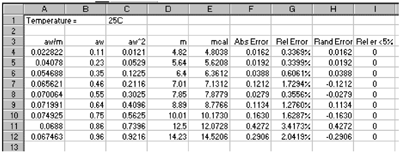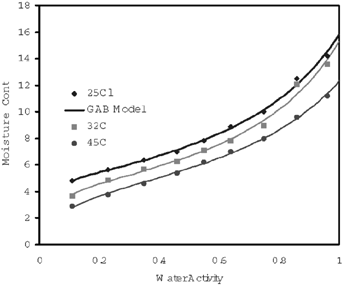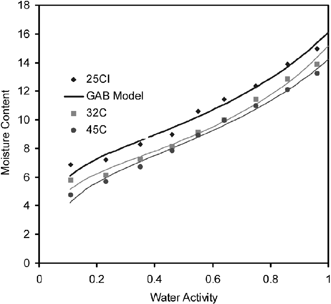ABSTRACT
Spreadsheets are versatile tools that can be used for preparation, plotting and analysis of data. One of such spreadsheets that is readily available on personal computers is Microsoft Excel. A Microsoft Excel template for computing the GAB constants was developed and tested with experimentally determined sorption data for lafun and soyflour each at temperatures of 25, 32 and 45°C. Lafun is a cassava product while soyflour is obtained from soybean. The experimental equilibrium moisture content for lafun and soyflour were determined for water activity ranging from 0.1 to 0.96 at each temperature. The results obtained showed that the GAB model is a good fit for the various experimental data. It was also shown that Excel gave the similar result as two other statistical software namely SPSS and STATISTICA.
INTRODUCTION
Available sorption isotherms for foods can be broadly divided into two groups namely linear and nonlinear models. Linear models are those that are linear with respect to the independent variables or can easily be linearized by simple transformations. Nonlinear models cannot be readily put in linear forms. Sanni et al.Citation[1] presented typical examples of these models. From our previous experience with sorption isotherms of cassava products,Citation1-3 the GAB modelCitation4-6 has been found to give the best fit for the various experimental data. The GAB model was capable of representing satisfactorily all isotherms, in all the domain of water activity and temperature studied. This model is also considered as one of the best in representing isotherms of food products.Citation[7] Only GAB model is considered in this work. Although the GAB model is nonlinear, it can be put in a linear form if the temperature is assumed to be constant.
The parameters of the linear models can be obtained by using regression analysis.Citation[8] Estimation of the parameters of the nonlinear models require the use of optimization techniques such as Hooke and Jeeve's method, Quasi-Newton methods and Powell's method.Citation[9] Generally speaking, optimization techniques are iterative while regression analysis techniques are not. Majority of the previous authors has solved these models using high level languages such as FORTRANCitation[2] or statistical packages such as STATISTICA.Citation[10] High level languages only give numerical outputs while some of the statistical packages can give both numerical and graphical outputs. These packages are, however, relatively expensive and not readily available on personal computer.
For personal computer, spreadsheets are more common and are good vehicles for preparation, plotting and analysis of data. One of such spreadsheet software is Microsoft Excel. Excel is part of Microsoft Office Suite and is pre-loaded with almost all new PC's that run on Windows platform. Hence there is no additional cost to the user. In this work, Microsoft Excel 97 template for obtaining the GAB model parameters using linear regression techniques is presented.
To test the template, sorption isotherms for lafun and soyflour, each at three different temperatures were used. Lafun is produced from cassava (Manihot esculenta) while soyflour is from soybean (Glycine max L (Merrill)). Although, Onayemi and OluwamukomiCitation[11] presented the sorption isotherm for lafun, there is negligible information available on the sorption isotherm of soyflour. To assess the accuracy of the Excel calculations, SPSS for WindowsCitation[12] and STATISTICACitation[13] also used to compute the GAB model parameters for the same lafun and soyflour sorption data.
MATERIAL AND METHODS
Cassava roots [variety: TMS 4(2) 1425] of about 9–12 months old was obtained from the University farm, University of Agriculture, Abeokuta. The roots were processed into lafun within 2–3 h of harvesting. Soybean seeds were purchased from Kuto market in Abeokuta, Nigeria.
Processing of Soybean Flour
The soybean was first sorted to remove dirt, stones, small pebbles and damaged seeds. The sorted seeds were then boiled for 25 min. This was done in order to prevent the beany flavor and off-odor due to increase in lipoxy activity. The boiling also soften the seed coat. The boiled seed was dehusked by removing the seed coat and then dried at 60°C in a cabinet dryer (LEEC F2) for 24 h. The dried material was grounded into flour using an attrition milling machine after which it was sieved to develop soybean flour.
Processing of Lafun
Cassava roots were processed into lafun using the methods described by Oyewole and Odunfa.Citation[14]
Determination of Equilibrium Moisture Content
The equilibrium moisture content was determined using the static gravimetric method as described by Pawar et al.,Citation[15] at temperatures of 25, 32 and 45°C. Further details on the procedure used for measuring water activity are given by Sanni et al.Citation[3]
GAB MODEL
The GAB model can be written as
The parameters A0, B0 and C0 are obtained using the LINEST function in Excel 97. Apart from these, LINEST also returns the correlation coefficient. Further details about the LINEST function can be obtained from the online Help in Excel. Equations Equation3-4 to Equation5 are then solved simultaneously to obtain the values for mo, c1 and c2.
The accuracy of the GAB model is evaluated by using three different indicators namely percentage deviation, correlation coefficient and residual plot. The percentage average deviation defined as:
Since the correlation coefficient is a scaled variable, it is used to indicate how well the linear form of the GAB model represents the sorption data. In the residual plot, the model error is plotted vs. the observed values.Citation[8]
EXCEL 97 TEMPLATE
The template for the GAB model contains 4 sheets namely Raw Data, GAB Temp 1, GAB Temp 2 and GAB Temp 3. (see Fig. ). The model computations are carried out in the appropriate temperature sheet. GAB Temp 1 sheet is for 25°C, Temp 2 is for 32°C and Temp 3 is for 45°C.
The Raw Data Sheet
It can be divided into three sections. The experimental values for aw and m at the three different temperatures are entered into cells A5 to F13 as shown in Fig. . Note that we have only nine pair of experimental values. However, the template has provision for up to 20 data points.
The summaries of the results for the three temperatures are placed in cells K1 to N11 of Raw Data Sheet (see Fig. ). The pertinent formulas for cells L3 to L11 are shown in Table . The formulas for cells M3 to N11 are obtained by replacing the sheet name with the appropriate sheet name for the temperature. The sorption isotherms as well as the random error plots are also put in the Raw Data sheet.
Table 1. Formulas for Cells L3 to L11
Model Computation
The computations are done in four steps. Note that only the computation details for GAB model Temp 1 sheet is presented here; the computations for other temperatures are similar.
| Step 1 | = |
Compute aw/m, aw and aw 2 using the values from the Raw Data sheet. These values are placed in cells A3 to C12 as shown in Fig. . |
| Step 2 | = |
The LINEST function is used to estimate the constants A0, B0 and C0 with the results put in cells A27, B27 and C27 respectively (see Fig. ) |
| Step 3 | = |
The GAB constants are then obtained by solving Eqs. Equation3-4 to Equation5 simultaneously and the results placed in cells B37 to B39 (see Fig. ) |
| Step 4 | = |
Using the GAB constants and the experimental water activity, the moisture content is calculated (cell E4 of Fig. ). The absolute error, relative error and random error are then calculated as shown in Fig. . |
The formulas for the different cells are shown in Table . Since the template is designed to take a maximum of 20 data points, it is necessary to know the actual number of data points. This is done in cells L3 to L8. The formulas are also included in Table . In addition, the Copy Command is used to fill up the formula for cells A5 to I12.
Table 2. Formulas for Model Computation
RESULTS AND DISCUSSION
The sorption isotherms for lafun and soyflour at different temperatures are shown in Figs. and respectively. It can be seen that for the range of water activity investigated, the moisture content decreases as the temperature is increased at a given relative humidity. Figures and also show that the curves are sigmoid-shaped and almost similar to each other. However, for any given temperature and water activity, soyflour has a higher adsorptive capacity than lafun especially at low water activities.
The curves shown in Figs. and were obtained by fitting the GAB equation to the experimental data over a water activity range of 0.11 to 0.96. The GAB constants for lafun as well as the statistical indicators are shown in Fig. while the corresponding values for soyflour are shown in Table . The random plots for the two products are shown in Fig. . The correlation coefficient is close to 1 (approximately 0.99), the average deviation is less than 5% and the random plots show no definite trend or pattern. This shows that the model is a good fit for the various experimental data. It can also be seen that the GAB model fits the Lafun data better than the soyflour data.
Table 3. Summary of Results for Soyflour
The constants A0, B0 and C0 (see Eq. Equation2) were also calculated using both SPSS and STATISTICA software for each of the six different sorption data sets in order to check the accuracy of the Excel software as well as the developed template. The results obtained showed that all the three software gave the same values for each of the data set. The same correlation coefficients were also obtained for the different data sets. We can therefore say that the template is correct and the level of accuracy of the Excel calculations is the same as that of SPSS and STATISTICA. It should be noted however, that since SPSS and STATISTICA are statistical software, they offer more statistical analysis options than is available in Excel. Nonetheless, for the sorption data, the information from the LINEST function in Excel is satisfactory. Apart from this, Excel can be used for other computations. For example the actual values of the GAB constants are calculated directly by Excel using the output from the LINEST function; it is not easy to do the same with either STATISTICA or SPSS.
CONCLUSION
A spreadsheet template for computing the GAB constants was described in detail. The template was used to compute the GAB constants for six different lafun and soyflour sorption data. The results show that the GAB model gives a good fit for the various experimental data. It was also shown that the level of accuracy of the Excel calculations is the same as that of SPSS and STATISTICA. The equilibrium moisture content were presented for lafun and soyflour at temperatures of 25°C, 32°C and 45°C. The equilibrium moisture contents were found to decrease with increase in temperature at any given water activity.
ACKNOWLEDGMENTS
The authors wish to thank A. W. Jimoh and A. O. Pedro for determining the sorption isotherms of Lafun and Soyflour for us.
REFERENCES
- Sanni , L.O. , Kolawole , A.G. , Akingbala , J.O. and Kuye , A. 1999 . Effect of Drying Methods on Moisture Sorption Isotherms of Fufu at Three Temperature . Drying Technology , 17 ( 1&2 ) : 285 – 297 .
- Sanni , L.O. and Kuye , A. Effect of Temperature on Water Sorption Isotherms of Some Fortified Cassava Products, Proceeding of the 12th International Drying Symposium, IDS2000 . Armsterdam : Elsevier Science . Paper no 23.
- Sanni , L.O. , Atere , C. and Kuye , A. 1997 . Moisture Sorption Isotherms of Fufu and Tapioca at Different Temperatures . Journal of Food Engineering , 34 ( 2 ) : 203 – 212 .
- Anderson , R.H. 1946 . Modification of the BET Equation . J. Am. Chem Soc. , 68 : 689 – 691 .
- de Boer , J.H. 1953 . The Dynamic Character of Adsorption , 2 Oxford Clarendom Press .
- Guggenheim , E.A. 1966 . Applications of Statistical Mechanics Oxford Clarendon Press .
- Monterrey-Q , E.S. and Sobral , P.J.A. Sorption Isotherms of Edible Films of Tilapia Myofibrillar Proteins, Proceeding of the 12th International Drying Symposium, IDS2000 . Armsterdam : Elsevier Science . Paper no 161.
- Shacham , M. , Brauner , N. and Cutlip , M.B. 1996 . Replacing Graph Paper with Inter active Software in Modeling and Analysis of Experimental Data . Computer Applications in Engineering Education , 4 ( 3 ) : 241 – 251 .
- Kuye , A. 1999 . Optimisation Techniques for Engineers and Management Scientists 53 – 84 . Lagos, , Nigeria : Denik and Associates Ltd .
- Yoshida , C.M.P. and Menegalli , F.C. Drying of Supersweet Corn, Proceeding of the 12th International Drying Symposium, IDS2000 . Armsterdam : Elsevier Science . Paper no 95.
- Onayemi , O. and Oluwamukomi , M.O. 1987 . Moisture Equilibria of Some Dehydrated Cassava and Yam Products . J. Food Process Eng. , 9 : 191 – 200 .
- SPSS Inc. SPSS for Windows Release 6.0. June 17 1993
- StatSoft Inc. STATISTICA for Windows (Computer Program Manual). Tulsa Ok, 1995
- Oyewole , O.B. and Odunfa , S.A. 1988 . Effects of Fermentation on Carbohydrate, Mineral and Protein Contents of Cassava During Fufu Production . J. of Food Composition Analysis , 2 : 170 – 176 .
- Pawar , V.S. , Pawar , D.K. , Rodge , V.D. , Surve , V.D. and More , D.R. 1992 . Moisture Adsorption Isotherms of Ground Tumeric at Different Temperature . J. Fd. Sc. and Techn. , 29 : 170 – 173 .






